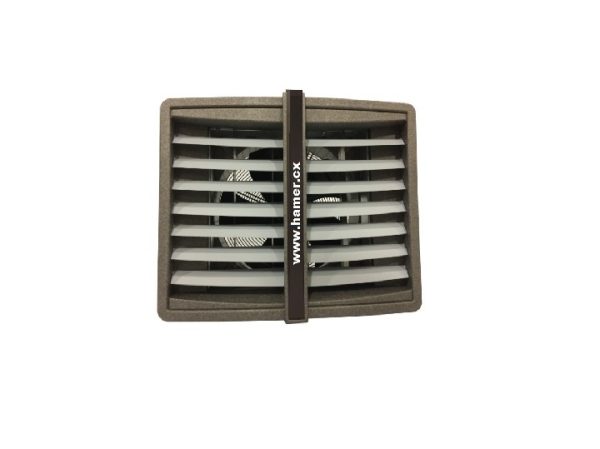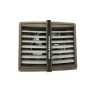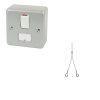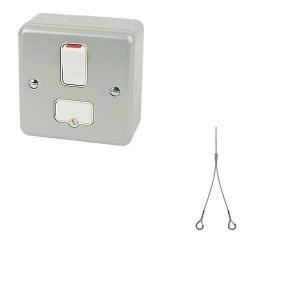Destratification Fan
From £284.17 Excl. VAT
Our Destratification fans are available in two models, DSF1 and DFS2. Each model can move different amounts of air, depending on the size of the building and application. Please continue reading for details.
- Description
- Additional information
Description
Our Destratification fans are available in two models, DSF1 and DFS2. Each model can move different amounts of air. Selection is dependant on the size of the building and application. Please continue reading for details.
How does a destratification fan work?
When warm air heating equipment is operated, heat rises by natural convection to the highest point of the building.
As the height of the building increases, so does the temperature gradient inside the building.
Large temperature gradients waste energy. The heating equipment runs for longer to maintain the required comfort level within the heated space.
In effect your building is heated from top down. In some cases the temperature in the roof can be over 10° higher than the temperature set point. This is called a high gradient.
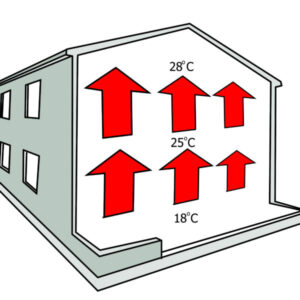
Our destratification fan is designed to recover the otherwise waste heat back down to ground level again.
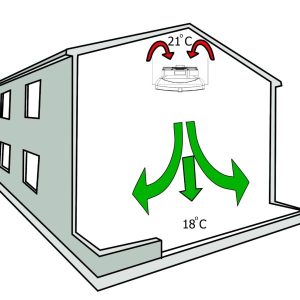
A reduced gradient means lower fuel costs with fuel savings of 15% achievable.
Destratification fans assist with maintaining a more uniform heat pattern throughout the heated space, often eliminating dead spots or hard to reach places.
Our destratification fan is constructed of a moulded foam material which not only looks amazing but cuts down the weight of the final unit.
Because of the foam construction, there is a sound deadening effect and no more vibrating noises.
Each unit is fitted with a genuine Honeywell Thermostat and pre-wired with 1.5m of flexible cable, ready to connect to an electrical supply.
Suspension and operation.
Our destratification fans are suspended with four eye bolts which screw into the sides of the fan. These fixings locate securely into a steel core within the destratification fan.
An additional mounting kit can be supplied containing two steel wire quick hangers and a switch fused spur to aid with installation.
Air movement can be directed by carefully adjusting the air diffuser blades to spread air over the work area.
Our fan motors have three speed settings and are compliant with current ErP Directives. An adjustable speed allows for more flexibility when the destratification fan is in use.
In most cases the thermostat should be adjusted to approximately 3° higher than the space set point. For example, a work place of 18° would require a set point of around 21° for optimum performance.
How to work out how many destratification fans are required?
Work out the volume of the building being heated (l * h * w) then multiply this by two for optimum air flow.
Make a note of this figure.
Next, divide this optimum airflow by the maximum air output of the destratification fan.
For example selecting DSF1, a building 40m long, 7m high and 20m wide.
Airflow = 2 * (40 * 7 * 20)
Airflow = 11,200
No fans = 11,200 / 4,800
No fans = 2.3, would round down to 2 fans.
Depending on the model selected, we suggest a hanging height of no more than 13m and 16m from floor level.
The fans should be located as high as possible within the building, leaving a gap of 600mm above the fan.
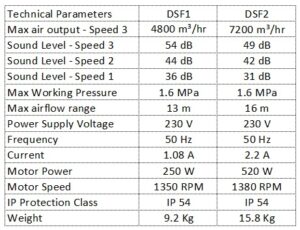
Delivery
We include delivery in the cost of our Destratification Fans to ship to the mainland United Kingdom, but excludes some areas of Scotland and Ireland and other off shore locations. Please contact us for additional shipping costs if required.
Warranty
We offer a 12 month return to base warranty on this product.
Links
Please contact us for free, friendly advise.
Additional information
| Destratification Fan Model | DSF1, DSF2 |
|---|

